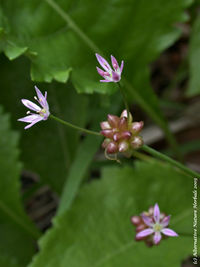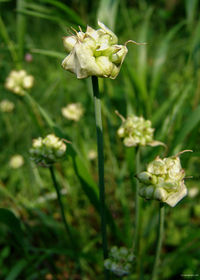Allium sativum
| See Also | Botanical Monographs |
|---|
Garlic (Allium sativum) is used as a tincture, oil and in food for upper respiratory infections and for the treatment of hypertension. To explore the characteristics, medicinal uses and prescribing considerations of this herb in more detail, check out the references indicated.[1], [2]
Contents
Characteristics
- Common Names: Garlic, Russian penicillin
- Family: Liliaceae
- Habitat: Allium sativum is native to Sicily, Asia Minor, Central Asia, but is now cultivated worldwide.
- Parts Used: Bulb with wedged segments
- Constituents: Disulphide containing products (allicin is converted to alliin via allinase)
- Medicinal Actions: alterative, antimicrobial, antifungal, antihelmintic, hypotensive, hypolipidaemic, stimulant, antioxidant, antiparasitic, cardiac tonic, carminative, decongestant, diaphoretic, expectorant, pectoral, rubefacient, vulnerary
Uses
Historical Uses:
Allium sativum has been used for medicinal purposes since approximately 3000 B.C. It has been used as an aphrodisiac as well as for colds, coughs, high blood pressure, diarrhea, rheumatism, snake bites, and as an antiseptic.
Medicinal Uses:
- As an antimicrobial for upper respiratory infections (cough, catarrh, pertussis, otitis media, hoarseness), intestinal parasites (worms), candidiasis
- Garlic is effective against bacterial, fungal, viral and protozoa infections.
- Garlic has a very low cytotoxicity.
- intermittent claudication, hypercholesterolemia, hyperlipidemia, mild to moderate hypertension (A. cepa is better for mild hypertension and A. sativum is better for moderate hypertension)
- Other
- cancer (protective especially for stomach and colon cancer), diabetes mellitus, syndrome X
Externally
- pneumonia (poultice), otitis media (ear oil)
Prescribing Considerations
The information provided is intended to augment the treatment from a naturopathic doctor or other trained medical professional. Although most herbs are generally safe, it is recommended that you avoid self-prescribing especially when there is an underlying ongoing medical condition, if you are on any prescription medications or if you are pregnant or breastfeeding.
Formulations and Preparation
- Tincture - 10-30 drops (or 20-40 drops) three times daily
- Dried/powered - 400-1200mg (1 clove ~250mg powered garlic)
- Allicin - 2-5mg daily
- Garlic oil (extracted) - 2-5mg daily
- Enema - 1 clove in 1/4-1/2 L water, boil a few minutes (for worms)
- Hypertension - 1 clove of A. sativum is comparable to 1 bulb of A. cepa
Fresh - use as desired; crushing, chewing, and juicing garlic will activate the enzymes to convert the constituent to its active form; cooking and roasting will destroy the active constituent
Safety
The safety and prescribing considerations for this herb include:[4] [5]
- Generally regarded as safe.
- Side-effects are heartburn, flatulence, and gastrointestinal upset (usually only at doses greater than 4 cloves daily); contact dermatitis (if the skin is exposed to raw garlic for an extensive period of time); post-operative bleeding.
- Caution and Contraindications: pregnancy and lactation (may cause infant colic in breastfeeding mothers ingesting garlic), surgery (discontinue use prior to surgery), organ transplants, pemphigus
- Drug-Herb Interactions.[4]
- Acetaminophen - Beneficial or supportive interaction not requiring professional management, prevention or reduction of drug adverse effect; Allium sativum inhibits cytochrome P450 2E1 which may reduce hepatoxic metabolite NAPQI formation (not clinically demonstrated, not applicable for management of acute acetaminophen toxicity).
- Dipyridamole and Related Antiplatelet Thromboprophylactics - Bimodal or variable interaction with professional management, potential or theoretical adverse interaction of uncertain severity or potential or theoretical beneficial or supportive interaction with professional management; Allium sativum may possibly be additive in increasing antiplatelet activity with dipyridamole (clinical significance not established, increased risk of bleeds likely overstated).
- Doxorubicin and Related Anthracycline Chemotherapy Agents - Potential or theoretical beneficial or supportive interaction with professional management, prevention or reduction of drug adverse effect; Allium sativum protects against and reduces drug-induced cardiotoxicity through multiple mechanisms, including increasing myocardial antioxidant status (not clinically demonstrated).
- HMG-CoA Reductase Inhibitors (Statins) - Potential or theoretical beneficial or supportive interaction with professional management, prevention or reduction of drug adverse effects; Additive inhibition of HMG-CoA theoretically allows lowered statin dose and reduction of drug adverse effect (plausible but not clinically established).
- Mucositis-Inducing Chemotherapeutic Agents, Including Fluorouracil, Bleomycin, Doxorubicin, and Ethanol - Potential or theoretical beneficial or supportive interaction with professional management, prevention or reduction of drug adverse effects; Allium sativum may prevent and reduce chemotherapy-induced mucositis through anti-inflammatory and antioxidant mechanisms (not clinically established).
- Saquinavir and Related Antiretroviral Protease Inhibitors - Potential or theoretical adverse interaction of uncertain severity, impaired drug absorption and bioavailability, precautions appropriate; Possible pharmacokinetic interaction with saquinavir and reduces drug bioavailability but does not occur with ritonavir (unknown significance and applicability to related protease inhibitors). Monitor serum drug levels.
- Warfarin and Related Oral Vitamin K Antagonist Anticoagulants - Potential or theoretical adverse interaction of uncertain severity, potential or theoretical beneficial or supportive interaction with professional management; Theoretical additive effects on hemostasis caused by possible platelet inhibition (clinical studies suggest interaction insignificant). Monitor INR and check for peripheral bleed symptoms.
References
- ↑ Boon Heather, Smith Michael (2009) 55 Most Common Medicinal Herbs: The Complete Natural Medicine GuideSecond Edition Institute of Naturopathic Education and Research, CCNM Toronto.
- ↑ Godfrey Anthony, Saunders Paul, Barlow Kerry, Gowan Matt (2011) Principles and Practices of Naturopathic Botanical Medicine, Advanced Botanical Medicine. V3 CCNM Press, Toronto.
- ↑ Zare A, Farzaneh P, Pourpak Z, Zahedi F, Moin M, Shahabi S, Hassan ZM (Sep 2008) Purified aged garlic extract modulates allergic airway inflammation in BALB/cmice. Iran J Allergy Asthma Immunol;7(3):133-41. PMID: 18780948.
- ↑ 4.0 4.1 Stargrove Mitchell Bebell, Treasure Jonathan, McKee Dwight L (2008) Herb, Nutrient and Drug Interactions: Clinical Implications and Therapeutic Strategies.
- ↑ Brinker Francis (1997) Herbal Contraindications and Drug Interactions: Plus Herbal Adjuncts With Medicines, 4th Edition Eclectic Medical Publications.

